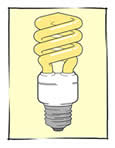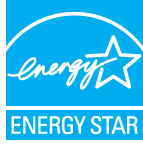 ENERGY STAR is an energy efficiency rating program developed by the U.S. Department of Energy and the U.S. Environmental Protection Agency. Most people are familiar with ENERGY STAR labeled home appliances and light bulbs, but many people may not be aware that the label is applied to more than 60 different types of products (for residential use as well as commercial building use), including heating and cooling equipment, roofs, and many types of electronics. (Note: Heating and cooling are the largest sources of energy consumption in homes; they account for almost half of a typical home’s energy consumption and energy costs.)
ENERGY STAR is an energy efficiency rating program developed by the U.S. Department of Energy and the U.S. Environmental Protection Agency. Most people are familiar with ENERGY STAR labeled home appliances and light bulbs, but many people may not be aware that the label is applied to more than 60 different types of products (for residential use as well as commercial building use), including heating and cooling equipment, roofs, and many types of electronics. (Note: Heating and cooling are the largest sources of energy consumption in homes; they account for almost half of a typical home’s energy consumption and energy costs.)
 Specific examples of products for which you can find ENERGY STAR qualified models include: air conditioners (central or room), ceiling fans, exhaust/ventilation fans, furnaces, boilers, thermostats, water heaters, refrigerators and freezers, dishwashers, clothes washers, insulation, windows, skylights, roofs, doors, light fixtures and bulbs, as well as TVs, DVD players, phones, computers, monitors, printers, copiers, etc.
Specific examples of products for which you can find ENERGY STAR qualified models include: air conditioners (central or room), ceiling fans, exhaust/ventilation fans, furnaces, boilers, thermostats, water heaters, refrigerators and freezers, dishwashers, clothes washers, insulation, windows, skylights, roofs, doors, light fixtures and bulbs, as well as TVs, DVD players, phones, computers, monitors, printers, copiers, etc.
To find out which brands and models of a particular product have earned the ENERGY STAR label, or to compare the levels of efficiency among different models, go to the ENERGY STAR Qualified Products website. Also, check with your utility company to see if they offer rebates for purchasing energy efficient equipment or appliances; many utilities do.
Efficient Refrigerators
Among household appliances, the refrigerator tends to be not only the biggest appliance, but also the biggest energy hog. “ENERGY STAR qualified refrigerators require about half as much energy as models manufactured before 1993. … ENERGY STAR qualified refrigerator models use at least 20% less energy than required by current federal standards.” To find out how much energy and money you could save by replacing your refrigerator, check out this online calculator. And if you decide to upgrade to a more energy-efficient refrigerator, here’s info on how to recycle your old fridge and make sure the Freon is recycled/disposed of properly (Freon is a hazardous substance and it should not be dumped in a landfill).
To learn about other ways to save energy, peruse the helpful resources on these sites:
California’s Flex Your Power program
U.S. Department Energy’s Energy Efficiency & Renewable Energy (EERE) program: Consumer’s Guide
P.S. The U.S. EPA has also developed a WaterSense label for water-efficient plumbing fixtures and other water-saving products.

{ 0 comments… add one now }